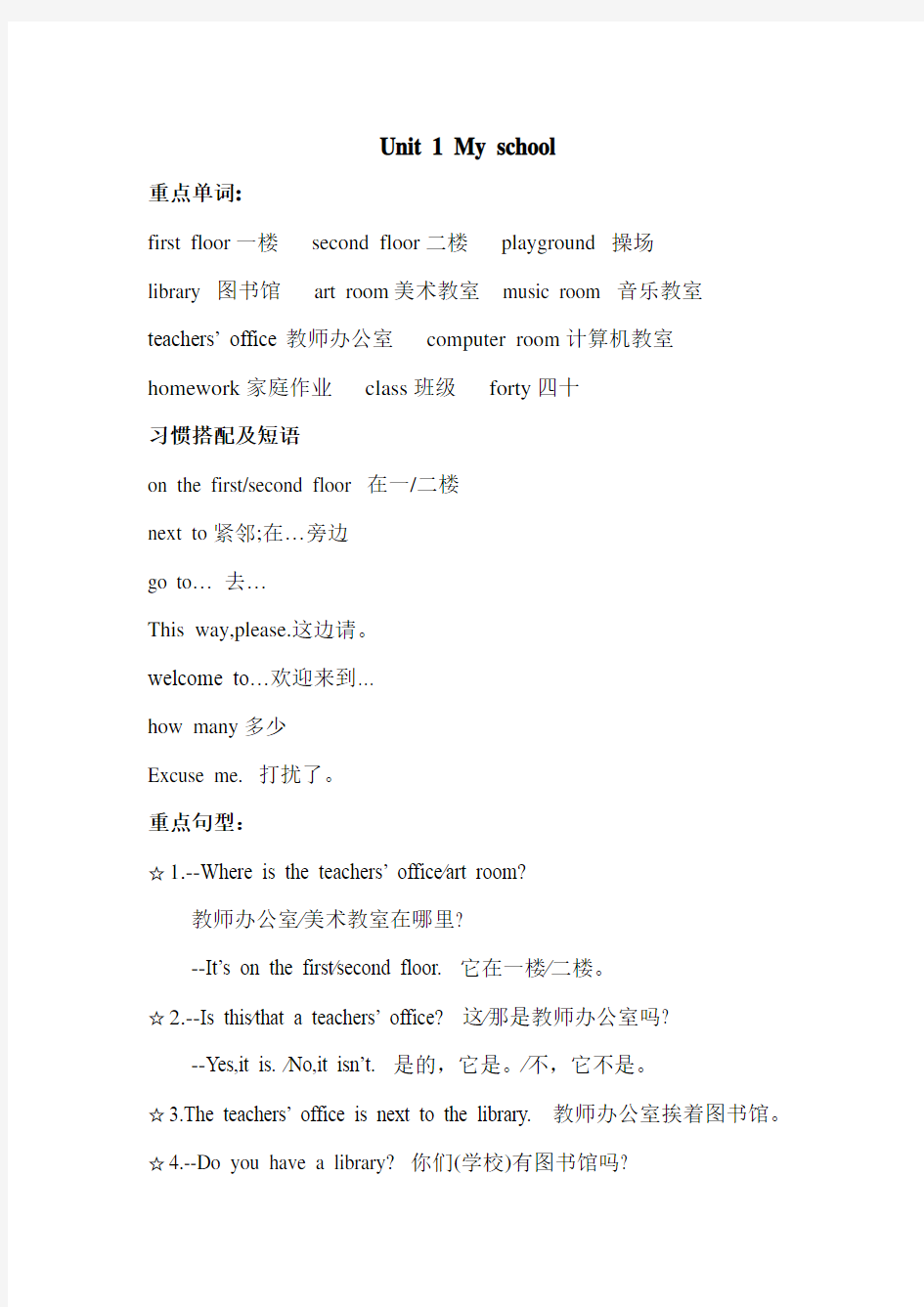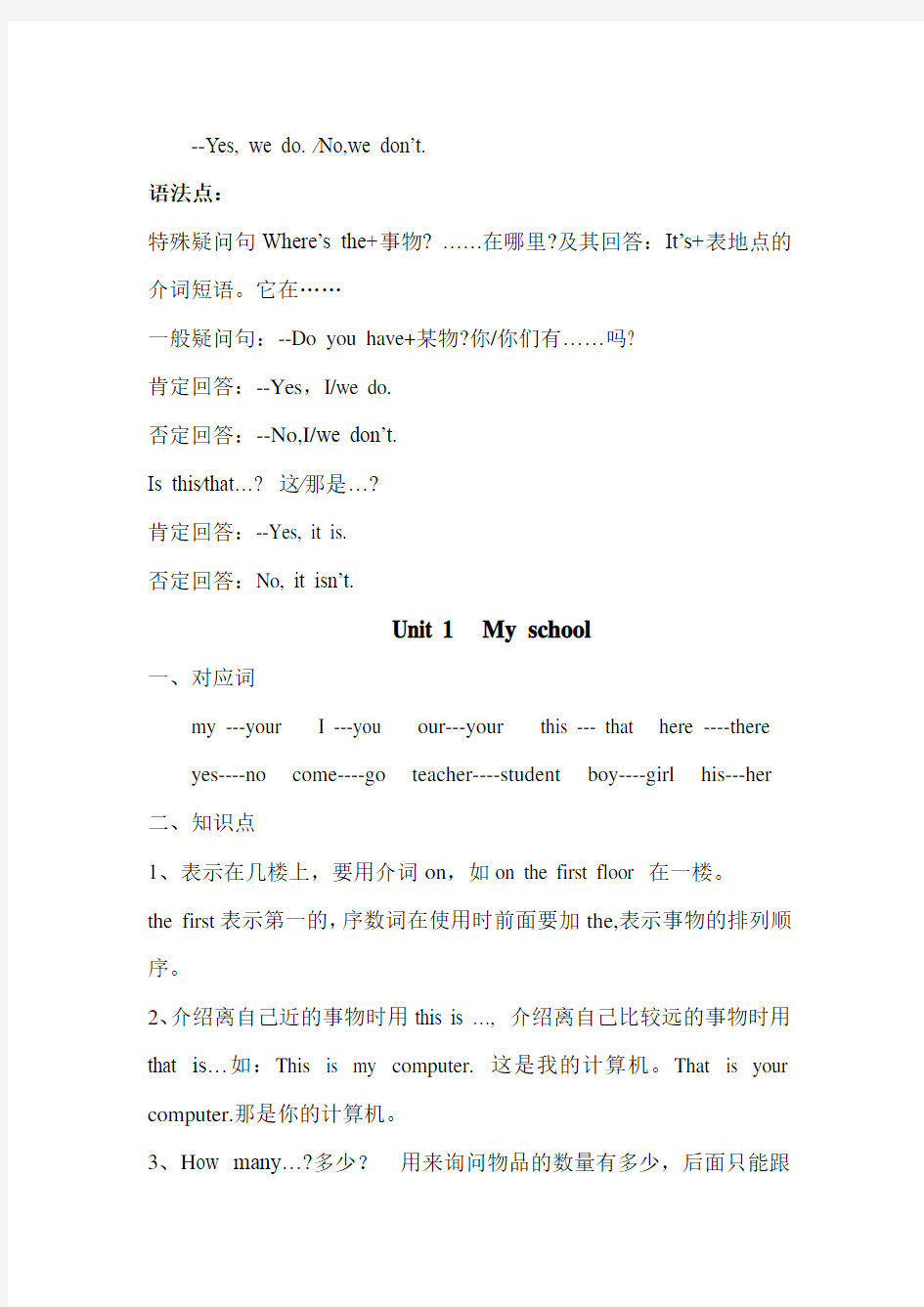

Unit 1 My school
重点单词:
first floor一楼second floor二楼playground 操场
library 图书馆art room美术教室music room 音乐教室teachers’ office教师办公室computer room计算机教室homework家庭作业class班级forty四十
习惯搭配及短语
on the first/second floor 在一/二楼
next to紧邻;在…旁边
go to…去…
This way,please.这边请。
welcome to…欢迎来到…
how many多少
Excuse me. 打扰了。
重点句型:
☆1.--Where is the teachers’ office∕art room?
教师办公室∕美术教室在哪里?
--It’s on the first∕second floor. 它在一楼∕二楼。
☆2.--Is this∕that a teachers’ office? 这∕那是教师办公室吗?
--Yes,it is. ∕No,it isn’t. 是的,它是。∕不,它不是。
☆3.The teachers’ office is next to the library. 教师办公室挨着图书馆。☆4.--Do you have a library? 你们(学校)有图书馆吗?
--Yes, we do. ∕No,we don’t.
语法点:
特殊疑问句Where’s the+事物? ……在哪里?及其回答:It’s+表地点的介词短语。它在……
一般疑问句:--Do you have+某物?你/你们有……吗?
肯定回答:--Yes,I/we do.
否定回答:--No,I/we don’t.
Is this∕that…? 这∕那是…?
肯定回答:--Yes, it is.
否定回答:No, it isn’t.
Unit 1 My school
一、对应词
my ---your I ---you our---your this --- that here ----there yes----no come----go teacher----student boy----girl his---her
二、知识点
1、表示在几楼上,要用介词on,如on the first floor 在一楼。
the first表示第一的,序数词在使用时前面要加the,表示事物的排列顺序。
2、介绍离自己近的事物时用this is …, 介绍离自己比较远的事物时用that is…如:This is my computer. 这是我的计算机。That is your computer.那是你的计算机。
3、H ow many…?多少?用来询问物品的数量有多少,后面只能跟
名词的复数形式。如How many books do you have?你有多少本书?4、当表示有一个时,名词的前面可以用a或者an.元音音素前用an , 辅音音素前用a,如an apple一个苹果an orange一个橙子 a pear 一个梨 a dog一只狗
5、当用Is this…? Is that…?提问时,肯定回答是:Yes, it is.否定回答是: No , it isn’t.
三、句子:
1、This is the teachers’ office.这是老师办公室。
2、That is my classroom.那是我的教室。
3、Go to the library. Read a storybook.去图书馆。读故事书。
4、Is this the library? Yes, it is.这是图书馆吗?是的。
5、Is that the art room? No, it isn’t. The art room is on the second floor(on the third; on the 4th; on the 5th…).
那是美术室吗?不是,美术室在二楼(三楼、四楼、五楼……)。
6、Where is the dining room? It’s on the first floor. (on the third; on the 4th; on the 5th…….)餐厅在哪里?在一楼。(三楼、四楼、五楼……)
7、How many students are there in you class? Forty.(数字)
8、Let’s go and have a look! 让我们去看一看。
四、单词:
playground garden library art room light picture teachers’ office computer room music room gym
teacher’s desk floor your computer fan this way, please
Unit2 What time is it?
重点词汇:
breakfast 早餐lunch午餐dinner 晚餐go to bed 上床睡觉English class 英语课music class音乐课PE class体育课
get up 起床go home 回家go to school 上学
习惯搭配及短语:
hurry up快点
come on快;加油
just a minute稍等一会儿
Breakfast is ready.早餐准备好了。
重点句型:
☆1. --What time is it now ? 现在几点钟了?
--It’s nine o’clock. 现在九点了。
☆2.It’s time for English class. 该是英语课的时候了。(for+ 名词)
☆3. It’s time to go to school. 该是去上学的时候了。(to + 动词原形) ☆4. It’s time to get up. 该起床了。
☆5. Time to go home ,kids. 该回家了,孩子们。
Unit 2 What time is it?
1、同义词:supper = dinner 晚饭
2、say (第三人称单数): says
3、同义句:What time is it? =What’s the time?现在几点了?
4、Let’s ... 后面直接跟动词的原形。如:Let’s go!让我们走吧!
Let’s clean the classroom.让我们打扫教室吧!
5、It’s time for …后面跟名词。如:It’s time for dinner. 该吃晚饭了。
It’s time for English class.该上英语课了。
It’s time to…后面跟动词。如:It’s time to eat dinner. 该吃晚饭了。
It’s time to have English class. 该上英语课了。
一、句子:
1、What time is it? 几点钟了?
2、It’s nine o’clock.现在九点。
3、It’s time for English class.该上英语课了。(lunch, English class, music class, breakfast, dinner, PE class)
4、School is over. Let’s go to the playground.放学了,让我们去操场吧!
5、It’s time to go to school.该去学校了!(get up, go to school, go to bed, go home)
6、That one is correct
二、单词:
lunch English class music class breakfast dinner PE class
get up go to school go to bed go home just a minute
one two three four five six seven eight nine ten
it’s=it is math Chinese English PE music class
Unit 3 Weather
重点词汇:
warm 暖和的cold 寒冷的cool 凉爽sunny晴朗的hot 炎热的rainy 下雨的windy 有风的cloudy 多云的snowy 下雪的
习惯搭配及短语:
weather report 天气预报be careful 小心
重点句型:
☆1.--What’ s the weather like in Beijing ? 北京的天气怎么样?
-- It's warm today .今天很暖和。
-- How about New York ? 纽约怎么样?
☆2.--Can I go outside now? 现在我能出去吗?
--Yes,you can. 可以∕No,you can’t. It’s cold outside∕不行.外面冷。☆3.--Is it cold? 天冷吗?
--Yes,it is.是的。No,it isn’t.不,不冷
--It’s 26 degrees. 是26度。
语法点:
特殊疑问句:
--What’ s the weather like in+某地?(……天气怎么样?)
--It’s +表示天气的形容词。
一般疑问句:
Can I+动词原形?(我能……?)
肯定回答:Yes,you can. 否定回答:No,you can’t.
Unit 3 Weather
一、对应词:
close ----open put on----take off cold----hot warm----cool
复数形式:foot----feet (脚)
二、表示天气的几个形容词都是同是由相应的名词变化而来的,它们的对应形式是:
名词形式形容词形式
rain 雨rainy 下雨的
snow雪snowy下雪的
wind 风windy 有风的
cloud 云cloudy 有云的
sun阳光sunny晴朗的
三、一般疑问句Can you…?的回答形式有两种,肯定回答是:Yes, I can. 否定回答是: No, I can’t.一般疑问句Can I …? 的回答形式也有两种,肯定回答是:Yes, you can. 否定回答是: No, you can’t.
四、同义词:How about …? ===What about …?怎么样?
五、当问某个地方的天气如何时,要用
What’s the weather like in +地名?
如:What’s the weather like in Beijing?北京的天气怎么样?
Unit 4 At the farm
一、词汇
tomato 西红柿potato马铃薯、土豆green bean 豆角、四季豆carrot 胡萝卜horse 马cow 母牛、奶牛sheep 羊、绵羊hen 母鸡these(this 的复数形式)这些yum(表示味道或气味非常好)animal兽、动物those(that的复数形式)那些garden花园、菜园farm农场goat山羊eat吃fork 叉子born 出生world 世界world map 世界地图
二、句型:
1、---How many horses do you have ? ---Seventeen.
---你有多少匹马?---17匹
2、What are these? Are these potatoes? 这些是什么?这些是土豆吗?
3、---Let me try one . They’re carrots.让我试一个。它们是胡萝卜。
4、Look at these! Are these carrots? 看这些!这些是胡萝卜吗?--Yes, they are.是的,它们是胡萝卜。--Wow! They’re so big ! 哇,它们很大!
5、What are these? 这些是什么?--They’re tomatoes. 它们是西红柿。--But they’re yellow! 但它们是黄色的。--Try some! They’re good. 试吃一些,它们很好吃。--Thanks. Y um. 谢谢。很美味!
6、Look at the green beans. They’re so long! 看豆角,它们很长! --Yes, and the potatoes are big.是的,土豆也很大。
7、You have a lot of animals! What are those? 你有很多动物!那些是什么?--They’re horses.它们是马。
8、What about those? Are they hens?那些呢?它们是母鸡吗?--No, they aren’t . They’re ducks.不,它们不是。它们是鸭子。
9、These are sheep. 它们是绵羊。--They’re so cute ! 它们很可爱。
10、This is the vegetable garden. 这是菜园。--These are carrots and potatoes.这些是胡萝卜和土豆。
11、Those are tomatoes and green beans over there. 在那里的是西红柿和四季豆。
12、There are animals, too. What are these? 这也是动物。这些是什么?--They are sheep.它们是绵羊。
13、Are those sheep? No, they are goats. They love to eat carrots! 那些是绵羊吗?不,它们是山羊。它们喜欢吃胡萝卜。
14、I don’t like vegetables . 我不喜欢蔬菜。
15、I like chicken and eggs.我喜欢鸡肉和鸡蛋。
三、语法:
(一)复数形式
sheep---sheep (绵羊) hen---hens(母鸡)lamb---lambs(羊羔) goat---goats(山羊)cow---cows(奶牛)horse---horses(马)goose---geese(鹅) foot---feet(脚) tooth---teeth(牙齿) (二)可数名词变复数的规则:
1、一般情况下,在单数名词词尾加“s”.如:cat---cats dog---dogs
book---books ruler---rulers
2、在以s, ss , x , sh , ch 结尾的名词后面加“es”,如:box---boxes peach---peaches bus---buses class---classes
3、在以o结尾的单词后面加“es”,如:tomato---tomatoes potato---potatoes
4、以元音字母加y结尾的名词,直接加“s”如:boy---boys toy---toys day---days 以辅音字母加y结尾的名词,去掉y后加“ies”,如:baby---babies lady---ladies butterfly---butterflies
5、以f, fe结尾的名词,去掉f或fe后加“ves”,如:shelf---shelves leaf---leaves knife---knives
(三)I like…后面要加可数名词的复数形式或者不可数名词,如:I like apples . 我喜欢苹果。I like chicken.我喜欢鸡肉。
(四)特殊疑问句:
What are these? What are those ? What are they?在回答时,都要用“They are…” What is this ? What i s that? What is it ? 在回答时都要用It’s a (an )… 一般疑问句:Are these …? Are those …? Are they…?的回答形式也都是一样的,肯定回答:Yes, they are. 否定回答:No, they aren’t. 一般疑问句:Is this a(an) …? Is that a(an ) …? Is it a(an)…?的回答形式也都是一样的,肯定回答:Yes, it is. 否定回答:No, it isn’t.
Unit 4 At the farm
一、复数形式
sheep—sheep (绵羊)hen—hens(母鸡)lamb—lambs(羊羔) goat—goats(山羊)cow—cows(奶牛)horse—horses(马)goose—geese(鹅) foot—feet(脚)tooth—teeth(牙齿)
二、可数名词变复数的规则:
1、一般情况下,在单数名词词尾加“s”.如:
cat—cats dog—dogs book—books ruler—rulers
2、在以s, x , sh , ch 结尾的名词后面加“es”,如:
box—boxes peach—peaches bus—buses class—classes
3、在以o结尾的单词后面加“es”,如:
tomato—tomatoes potato—potatoes
4、以元音字母加y结尾的名词,直接加“s”如:
boy—boys toy—toys day—days
以辅音字母加y结尾的名词,去掉y后加“ies”,如:
baby—babies lady—ladies butterfly—butterflies
5、以f, fe结尾的名词,改f或fe为v后加“es”,如:
shelf—shelves leaf—leaves knife—knives
三、I like…后面要加可数名词的复数形式或者不可数名词,如:
I like apples . 我喜欢苹果。I like chicken.我喜欢鸡肉。
四、特殊疑问句:What are these? What are those ? What are they?在回答时,都要用“They are…”